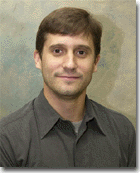| Laboratory of Molecular Gerontology |
Intramural Program Investigators ^ Home ^ |
| David M. Wilson, III, Ph.D., Investigator Unit of Structure and Mechanism in Base Excision Repair |
 Dr. David Wilson completed his Ph.D. work in 1993 at Loyola University of Chicago, Stritch School of Medicine, as part of the Molecular Biology Program. Dr. Wilson then performed his postdoctoral research training at the Harvard School of Public Health until 1997, when he became a Senior Biomedical Scientist at Lawrence Livermore National Laboratory in the Biology and Biotechnology Research Program. While at Livermore, he was also briefly an adjunct faculty member at the University of California, Davis. Dr. Wilson started his present position at NIA in 2002. Dr. David Wilson completed his Ph.D. work in 1993 at Loyola University of Chicago, Stritch School of Medicine, as part of the Molecular Biology Program. Dr. Wilson then performed his postdoctoral research training at the Harvard School of Public Health until 1997, when he became a Senior Biomedical Scientist at Lawrence Livermore National Laboratory in the Biology and Biotechnology Research Program. While at Livermore, he was also briefly an adjunct faculty member at the University of California, Davis. Dr. Wilson started his present position at NIA in 2002.Research Interests: Base Excision Repair: Base excision repair (BER) is the major pathway for correcting most spontaneous and oxidative DNA damage. In brief, the main steps of BER consist of: (1) excision of the damaged base (e.g. 8-oxoguanine), (2) incision of the DNA backbone at the abasic site product, (3) removal of the abasic terminal fragment, (4) gap-filling synthesis, and (5) ligation of the final nick. Our focus has been to understand the molecular mechanisms of repair of abasic sites and oxidative DNA single strand breaks, and to define the coordinated effort between the proteins of BER. Towards this end, we have isolated several BER proteins and have developed biochemical assays to assess their individual and cooperative structure-function relationships. |
| The Major Human Abasic Endonuclease, Ape1: Ape1 is the major corrective enzyme for abasic sites in DNA, initiating repair of this common lesion by incising the phosphodiester backbone 5' to the damage site. This enzyme also functions in specific strand break contexts to remove 3'-oxidative blocking termini, e.g. phosphate and phosphoglycolate residues, from DNA. Recently, the 3' to 5' exonuclease activity of Ape1 was found to contribute to the excision of certain 3'-mismatched nucleotides, a function likely important in maintaining genetic integrity. Our efforts continue to define the biochemical and mechanistic properties of this essential and multi-functional mammalian DNA repair enzyme. |
| Single-Strand Break Repair Protein, XRCC1: XRCC1 has been proposed to operate as a critical scaffolding factor in BER by binding DNA single strand breaks (specifically nicks and gaps) and recruiting other BER proteins, such as DNA polymerase b. We are defining the in vitro and in vivo functional consequences of specific XRCC1 interactions, as well as searching for novel complex partners. Additional analysis includes defining the cellular phenotypes of XRCC1 mutant cell lines, and characterizing the activities of site-specific mutant and variant XRCC1 proteins. |
| Structure-Function Mechanism: Proteins of BER are often found to complex with or to regulate the functional capacity of other pathway participants. However, in many instances, the mechanism by which these proteins interact or communicate is unknown. Through collaborative efforts employing sophisticated biophysical techniques, most notably nuclear magnetic resonance (NMR) spectroscopy, we are working to define the precise protein-protein contact interfaces and to determine the contribution of protein- and DNA-dynamics to pathway coordination. |
| Susceptibility Factors: A related area of research includes determining the impact of genetic variation on DNA repair function. It has been proposed that certain genetic differences found in the human population will result in proteins that are less effective at repairing DNA damage, thus rendering the affected individual more susceptible to environmental or food agent exposures that create DNA lesions. By defining the functional capacity of variants in the oxidative DNA damage response pathways, we are building a foundation on which we can better predict the relationship of variation to human disease and the aging process. Additional analysis includes evaluating the effect of environmentally-relevant metal ions on DNA repair efficiency, with the belief that certain metal compounds will inhibit specific DNA repair responses. |
| Contact Information: Laboratory of Molecular Gerontology Biomedical Research Center, room 06B117 251 Bayview Boulevard, Suite 100 Baltimore, MD 21224-6825 Phone 410-558-8153 Fax 410-558-8157 E mail wilsonda@grc.nia.nih.gov For more information about the Laboratory: http://www.grc.nia.nih.gov/branches/lmg/lmg.htm |
| IRP Home What's New Contact Us Accessibility Disclaimer Privacy Site Search Site Map NIA Home |
 |
 |
 |